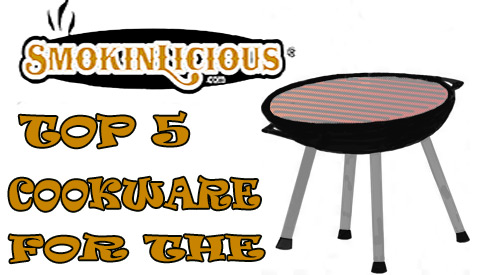Sat 26 Sep 2020
COOKWARE FOR THE GRILL
Posted by DrSmokeRead other related stories: General Smoking Information , Smoking Tips
No Comments

Enjoy our COOKWARE FOR THE GRILL
COOKWARE FOR THE GRILL-THAT WORKS!
Top 5 cookware accessories for your grill Share on X

If you’ve followed my writings for some time now, you’ve likely learned that I believe outdoor equipment is the same if not better than the traditional indoor options. You literally can make anything on the outdoor equipment that you make inside your home.
Knowing this, I have received many questions regarding the type of cookware that I use when grilling and/or smoking on said equipment. Today, I’m going to discuss the preferred cookware materials and the potential issues that can arise if you use a material that is not considered ideal for high heat temperatures.
Material #1: Cast Iron- Cookware for the Grill
This is my first choice and many other cooks, and the only material I use when I coal cook with cookware. Why? It is durable, it is relatively inexpensive, it is unbelievable at heat retention, and you can cook almost anything in it. Literally, it never wears out!
Downside? It is a material that needs to be maintained meaning oiled consistently. It is heavy!
Material #2: Carbon Steel- Cookware for the Grill
Carbon steel is a beast at retaining heat and it can be used on any cooking surface. Although lighter in weight than cast iron it is still heavier than stainless steel. Similar in many attributes to cast iron, it also requires frequent seasoning and the base of the pan will become discolored from the high heat exposure. Plus, it is not dishwasher safe so you need to love this material and be willing to put some work into maintaining it. If you’re lucky enough to find a piece you love, you will make magic in it whether near or in the fire.
Material #3: Stainless Steel Combo
I’m sure every one of us owns at least one piece of stainless steel. This is a very attractive piece of cookware from the aesthetic view. However, on its own, stainless steel is not the best heat conductor. This is the main reason why it often is combined with another material to improve its heat retention properties and keep it light in weight. Suitable pairs you’ll find for stainless steel include copper and aluminum. All three of these materials on their own, are not ideal. Cooper and aluminum heat very quickly which means they can burn very quickly as well, while stainless steel on its own can take forever to heat up. But combine copper and aluminum or aluminum and steel and you have an ideal heat conductor and safe high heat material. Rule of thumb: never use aluminum and copper cookware on their own for high heat cooking.
Material #5: Enameled Cast Iron- Cookware for the Grill
Know as the “pretty” cookware, enameled cast iron is cast iron at the heart-and-soul but with beautiful ceramic enamel outside surfaces. It has fabulous heat conductivity and retention but it is not non-stick which can cause some issues. I find it works really well when I use more of a two-zone cooking set up rather than direct coal or heat cooking.
Material #5: Non-Stick
Teflon is a non-stick, promoted material, that should be avoided. It has no ability to be used for high heat and in fact, excessive heat can melt this material. Also, Teflon is documented to flakes off after extended use, moving these flakes into your foods. At higher temperatures, the material produces toxic fumes that have been proven to be a health risk.
What Are High Heat Levels?
Now we know what materials are optimal for high heat cooking but what are the actual temperatures that can be handled?
Cast iron and stainless-steel combos can tolerate 1500°F, with stainless steel excelling to 2200°F. Although copper has a melting point of 1984°F and aluminum at 1221°F, cast iron, and steel materials in cookware still perform the best.
Now you have the education behind your choice of cookware. My last piece of advice is to always think about how you plan to use the cookware. If you love to nestle in the coals or be as close to the flame as you can, the items that may not look as pretty are likely the best choice. Take our tips in this blog USEFUL COOKWARE OPTIONS FOR YOUR GRILL and expand you cooking/Grilling skills and techniques!
SmokinLicious® products used in this blog:
Wood Chunks: Double & Single Filet

More Related reading on Cookware for the Grill
Related reading:
-TOP TOOLS NEEDED FOR GAS GRILLING
-TOP TOOLS TO OWN FOR CHARCOAL GRILLING

Dr. Smoke- I hope you enjoyed this blog- Cookware for the Grill!


